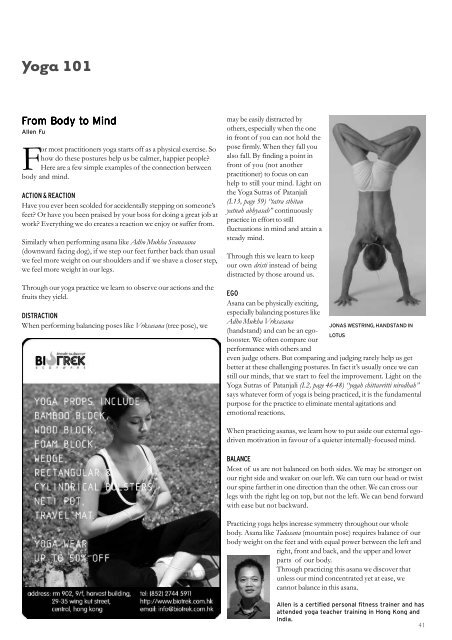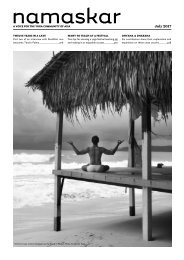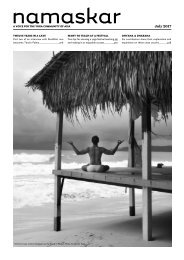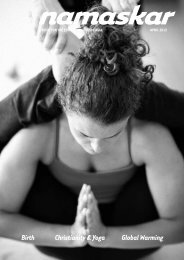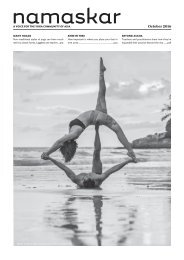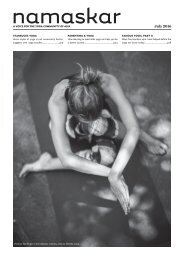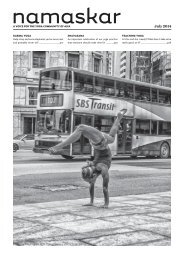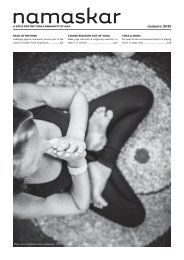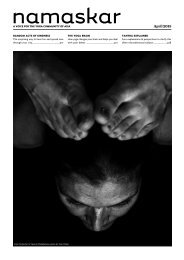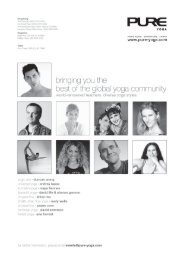Namaskar - Oct 09
Create successful ePaper yourself
Turn your PDF publications into a flip-book with our unique Google optimized e-Paper software.
Yoga 101<br />
From Body to Mind<br />
Allen Fu<br />
For most practitioners yoga starts off as a physical exercise. So<br />
how do these postures help us be calmer, happier people?<br />
Here are a few simple examples of the connection between<br />
body and mind.<br />
ACTION & REACTION<br />
Have you ever been scolded for accidentally stepping on someone’s<br />
feet? Or have you been praised by your boss for doing a great job at<br />
work? Everything we do creates a reaction we enjoy or suffer from.<br />
Similarly when performing asana like Adho Mukha Svanasana<br />
(downward facing dog), if we step our feet further back than usual<br />
we feel more weight on our shoulders and if we shave a closer step,<br />
we feel more weight in our legs.<br />
Through our yoga practice we learn to observe our actions and the<br />
fruits they yield.<br />
DISTRACTION<br />
When performing balancing poses like Vrksasana (tree pose), we<br />
may be easily distracted by<br />
others, especially when the one<br />
in front of you can not hold the<br />
pose firmly. When they fall you<br />
also fall. By finding a point in<br />
front of you (not another<br />
practitioner) to focus on can<br />
help to still your mind. Light on<br />
the Yoga Sutras of Patanjali<br />
(I.13, page 59) “tatra sthitau<br />
yatnah abhyasah” continuously<br />
practice in effort to still<br />
fluctuations in mind and attain a<br />
steady mind.<br />
Through this we learn to keep<br />
our own dristi instead of being<br />
distracted by those around us.<br />
EGO<br />
Asana can be physically exciting,<br />
especially balancing postures like<br />
Adho Mukha Vrksasana<br />
JONAS WESTRING, HANDSTAND IN<br />
(handstand) and can be an egobooster.<br />
We often compare our<br />
LOTUS<br />
performance with others and<br />
even judge others. But comparing and judging rarely help us get<br />
better at these challenging postures. In fact it’s usually once we can<br />
still our minds, that we start to feel the improvement. Light on the<br />
Yoga Sutras of Patanjali (I.2, page 46-48) “yogah chittavritti nirodhah”<br />
says whatever form of yoga is being practiced, it is the fundamental<br />
purpose for the practice to eliminate mental agitations and<br />
emotional reactions.<br />
When practicing asanas, we learn how to put aside our external egodriven<br />
motivation in favour of a quieter internally-focused mind.<br />
BALANCE<br />
Most of us are not balanced on both sides. We may be stronger on<br />
our right side and weaker on our left. We can turn our head or twist<br />
our spine farther in one direction than the other. We can cross our<br />
legs with the right leg on top, but not the left. We can bend forward<br />
with ease but not backward.<br />
Practicing yoga helps increase symmetry throughout our whole<br />
body. Asana like Tadasana (mountain pose) requires balance of our<br />
body weight on the feet and with equal power between the left and<br />
right, front and back, and the upper and lower<br />
parts of our body.<br />
Through practicing this asana we discover that<br />
unless our mind concentrated yet at ease, we<br />
cannot balance in this asana.<br />
Allen is a certified personal fitness trainer and has<br />
attended yoga teacher training in Hong Kong and<br />
India.<br />
41


